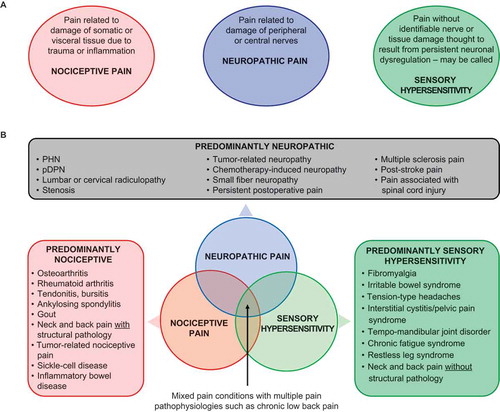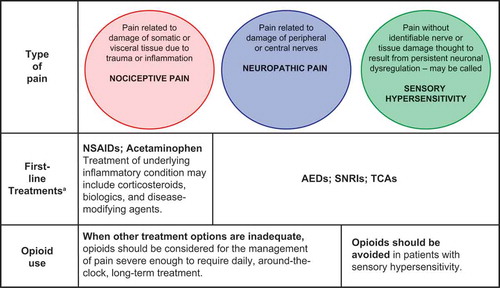Figures & data
Figure 1. (A) The three main types of pain pathophysiology give rise to chronic pain conditions. (B) These types of pain may present separately or in combination to contribute to the overall pain experience.
PHN = postherpetic neuralgia; pDPN = painful diabetic peripheral neuropathy.

Table 1. Consensus among guidelines for the treatment of chronic pain.
Table 2. Patient pain descriptors/reported symptoms among the three types of pain.
Figure 2. Recommended medication classes for the three types of pain pathophysiology.
aBased on strength of clinical evidence. NSAIDs = nonsteroidal anti-inflammatory drugs; AEDs = antiepileptic drugs; SNRIs = serotonin-norepinephrine reuptake inhibitors; TCAs = tricyclic antidepressants.

Figure 3. A 4-step approach to universal precautions for opioid prescribing in patients with chronic pain.
Universal precautions in opioid prescribing for chronic pain are recommended. Used with permission from www.rethinkopioids.com[Citation72] Copyright ©2014 Pfizer Inc.
![Figure 3. A 4-step approach to universal precautions for opioid prescribing in patients with chronic pain.Universal precautions in opioid prescribing for chronic pain are recommended. Used with permission from www.rethinkopioids.com[Citation72] Copyright ©2014 Pfizer Inc.](/cms/asset/4c56d4e2-67c0-4488-be19-a9f46e85087e/ipgm_a_1188319_f0003_b.gif)
Table 3. Key elements regarding the assessment of the patient with chronic pain.
